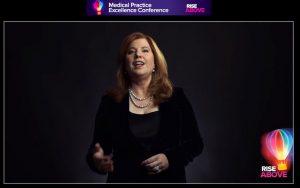This is Part II of Series on the Lessons Learned from Virtual Events. See Part I – Virtual Networking is Mostly a Bust.
I recently interviewed 8 conference organizers to find out what worked well and what didn’t this past year for virtual events, including:
- Emma Smith, Senior Vice President of Marketing at Kyruus
- Carol McNerney, Chief Marketing Officer at Ibi
- Megan Finnell, Director of Meetings & Conferences at MGMA
- George Huang MD, Director of Customer Experience & Success at Remo
In this second article, we will be exploring the challenges of virtual keynotes and educational sessions.
Quality Content is Key
One thing has become abundantly clear during the pandemic, people crave quality content no matter if it is delivered online or in-person. In fact, I would say that quality content is key to the success of an online event. Period.
In an informal poll of 12 members of the HITMC Community, all 12 responded that the topic of the session is the primary consideration as to whether they would sign up or attend an online event. Date/Time, speaker, and session type (panel vs keynote vs workshop) were also important, but secondary to the topic.
“Our attendees told us that it was the quality of the content that kept them hooked,” shared McNerney about the ibi annual user conference that pivoted online this year. “Our stats show that 40% of attendees stayed online for more than 10hrs over the 2 days of the event. “

Mix Practical and Novel Topics
Sessions that deliver practical, immediately actionable tips are always appreciated by audiences. This makes sense when you consider audience time constraints and the wealth of online events that are happening simultaneously. Would you sign up for a session if you didn’t think you would get something useful from it?
This doesn’t mean, however, that online healthcare events should be filled with nothing but healthcare-related topics. On the contrary, mixing up the topics so that there is variety can keep audiences engaged. On Virtual HITMC Day 2, we saw this first-hand.
On that day, we had a number of hard-hitting healthcare marketing sessions. Sandwiched between them were two sessions that were not: One on the importance of jingles and the other on how to look better on camera (webconferences). Both were interesting topics that had practical advice – just not from a purely healthcare perspective.
These two sessions were among the highest rated for the entire four day Virtual HITMC event. Why? Not just because it was quality content, but because the topics were novel. With the jingles session, it made the audience think differently about the relationship between sound and brand. The other session was full of practical tips on how to improve your lighting and camera angles to improve your look online.
“Variety is key,” said Smith. “No one wants to just sit there all day and listen to people talk.”
Get the Audience Involved
“The job of a keynote is to inform, entertain and inspire,” stated Huang. “There is nothing that says a keynote session can’t have a handout or workbook or an interactive poll. There is room for innovation and experimentation with keynotes. It doesn’t have to be just a lecture.”
Huang is a big fan of getting the audience involved in the session. Some of the most effective keynotes he has delivered and been in the audience for, have included workbooks where members of the audience are given time to fill out in the middle of the keynote. Even better, is when there is time baked into the keynote for the audience to share what they have written down with fellow attendees – usually at the table they are sitting at.
This interaction not only breaks up the lecture, it also helps the audience retain more of what the speaker was teaching.
Recorded vs Live Presentations
One of the biggest questions for event organizers is whether to pre-record the sessions and play them back during the event or to them live.

I agree with Smith. The first few virtual events I attended in March were mostly live presenters…and I would say more than 50% of them had some technical issues at the start. In some cases we had to wait 10-15min for the speaker to get online. After a few of those lets-wait-and-see-if-the-speaker-comes-on experiences, I grew to appreciate pre-recorded sessions.
“Having a mixture of live and pre-recorded sessions is acceptable,” shared Finnell. “For organizers pre-recorded sessions are much less stressful, but you can’t have your entire event pre-recorded. We made sure that our speakers were online and engaged the audience through the online chat feature while their recording was being played. This made a world of difference for the audience.”
We used this exact format for our EXPO.health Interactive Events and I can say first-hand that this works extremely well. Attendees really appreciated being able to ask questions of the keynote speaker and get additional context for what they were saying on screen.
Final Session Tips
The group of organizers I spoke to had these final tips to share about keynotes and sessions:
- Look for speakers who do well presenting online. Good in-person presenters may not do well virtually
- Keynotes need good at-home setups. Proper lighting, a good camera and fast Internet are a must
- If possible, don’t ask presenters to film themselves. Everyone does better when there is an audience. So have your technical crew or a volunteer group tune into the recording to give the presenter something to react to / someone to present to
- Spice up the recording by adding titles at the bottom of the video (called lower thirds) or putting focus on just the slide or just the speaker during the presentation
- Be sure not to fool the audience. Tell them if it is a pre-recorded session
In Part III we will summarize all the tips and lessons learned by these event organizers.







Add Comment